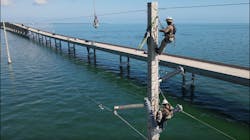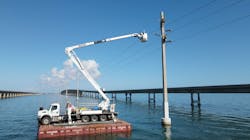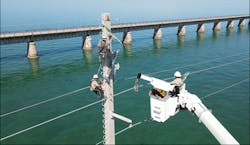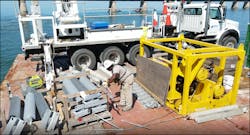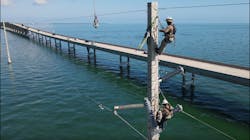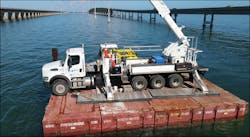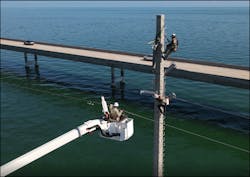BHI Energy Inc.’s barehand crews are hard at work over land and water. The power services company is using barges with trucks anchored over water locations and 125-ft bucket trucks over land to replace 1,473 insulators on 491 structures on 138-kV energized power lines.
“The significant advantage of live-line, or barehand, work is that there is no interruption in power delivery to thousands of customers,” said Randy Beckes, vice president of transmission for BHI Energy. “Crucial 138-kV high-voltage lines like these cannot be switched out and must remain energized.”
The first structure in this nine-month project starts in the water at southernmost Marathon, Florida, and the route runs in parallel with the 7-mile bridge to the Florida Keys and Key West. The Florida Keys are a 125-mile-long chain of islands that start south of Miami and are connected by the Overseas Highway’s 42 bridges over the Atlantic Ocean, Florida Bay and the Gulf of Mexico. Key West, which measures 2 miles by 4 miles, is the southernmost populated island of the Florida Keys, according to the Florida Keys and Key West Web site.
Since September 2020, linemen have been performing the extensive insulator replacements on both energized concrete poles and massive steel structures. Two five-person crews are replacing standard old polymer insulators with new LAPP polymer insulators, which offer longer-term protection against the effects of salt air and water because of the fiberglass and anti-rust alloy formulation.
Training Services
BHI Energy Power Services LLC provided the procedures, manpower and equipment for the Keys Energy Services’ 138-kV insulator replacement project in partnership with Grays Power Supply LLC, which was awarded the bid.
Energized electric power infrastructure work requires highly specialized training and months of preparation to perform work without interrupting vital power delivery to customers. In the barehand arena, BHI Energy carefully formulated specialized procedures for each job, outlining step-by-step instructions to get the job done safely and efficiently. These highly detailed procedures take into consideration the complexity and scope of each job, estimated manpower, specialized tooling, heavy equipment, terrain and weather conditions — all factors in preparing for each job.
BHI Energy maintains qualified barehand linemen crews, who are trained in comprehensive barehand and live-line principles annually. The crews receive supplemental refresher training every six months as well as ongoing field training. Becoming a barehand ream member requires exhibiting exceptional performance, mental acuity and safety adherence as a power delivery crew member. Qualified individuals are invited to take in-house specialized classroom and field training developed and managed by BHI Energy’s Beckes. Upon successful completion of this training, participants are eligible to move into company’s elite live-line group.
Focus On Safety
Prior to accepting the contract to replace 1,473 insulators with Keys Energy Services, BHI Energy’s barehand crews already had experience replacing this type of 138-kV dead-end insulators from a barge. Reserving a barge with a certified maritime captain who had live-line experience required a pre-contract check of the equipment and an interview with the company to ensure operating and safety measures would be met. The crew follows U.S. Coast Guard and Occupational Safety and Health Administration (OSHA) regulations as well as BHI Energy’s safety barehand rules and procedures. Unique safety measures and equipment include certified life jackets, for over-the-water work, and rescue training.
Working on the water in the Keys, where the Gulf of Mexico meets the Atlantic Ocean, strong winds and inclement weather are major factors and almost always impact the schedule. As a result, contingency plans were created and are enacted as needed to ensure the job is performed efficiently and on schedule.
While BHI Energy’s crews are prepared for all types of weather conditions, the unique nature of working on a floating barge under blazing heat — with the potential for high wind and wave action — has required additional preplanning and knowledge of possible delays. For example, tropical weather, high winds and rain have interrupted jobs because equipment must be relocated for safety.
“The view [in the Keys] is beautiful, but it can be extremely hot,” noted Job Foreman Scott Sansone. “And, in the end, you always have to respect the water, like when the weather causes the barge to rock. It’s very challenging work, every minute of every day, but I like the challenge and I love the water.”
Rain, wind, waves, lightning and sun exposure are all weather-related hazards the linemen are prepared for, with action plans ready to go as needed. The crews use fall protection, fire-resistant clothing, and specialized barehand suits and gloves, which can make it feel even hotter. They also use special insulated hot stick tools, made specifically for this work. Working at heights in buckets that take the linemen up the poles, sometimes more than 95 ft high, requires specialized training.
A Successful Project
In the Keys, power poles are located both on land by a major highway and in the water adjacent to bridges. The use of barges carrying secured and anchored bucket trucks enable the line crews to work at height from the barge in the water despite constant wave and wind factors, which make the job more challenging. The land-based poles are located on more easily accessible locations in flat terrain, mainly near roads, so the land-based portion has been less challenging than the mountainous and heavily vegetated terrains in which the linemen have worked previously.
Having the foresight to be adequately prepared for local conditions, factoring in possible delays and, most importantly, having qualified linemen and accurate work and safety procedures in place are necessities in managing a project like this one.
“What makes a challenging project a successful project is well-trained linemen understanding and following detailed barehand procedures, with safety being top of mind at all times,” Beckes said. “This is what we strive for at BHI Energy, with continuous training and safety, leaving no room for error.”
Amy Fischbach ([email protected]) is the Field Editor for T&D World magazine.
Basics of Barehand
On the project in the Florida Keys, BHI Energy’s crews are using the barehand live-line work method to get the job done safely and efficiently. Here is an overview of barehand work in the transmission and distribution industry, according to the Occupational Health and Safety Administration (OSHA) and Randy Beckes, vice president of transmission for BHI Energy.
- Linemen are in direct contact with energized conductors and must maintain minimum approach distances from the structure and all other grounded surfaces, as well as other lines and circuits.
- Barehand crews perform this work from an electrically insulated aerial device rated at 500 kV, such as a bucket truck, which has its platform insulated from the ground or earth. On the Florida Keys job, BHI Energy used a Terex-125 Aerial Barehand Truck, Beckes says.
- Similar to the concept of a bird landing on a power line, the barehand crews on the platform are charged to the same voltage as the line by electrically bonding or connecting the platform to the 138 kV power line.
- When bonded to the conductor, the live line crews must wear conductive hooded suits and gloves.
- Linemen who are not using aerial lifts to access the energized conductor instead rely upon insulated ladders or platforms.
On the Job: Replacing Insulators in the Florida Keys
Replacing insulators over land and water requires a carefully orchestrated plan. The following is a step-by-step overview of the work process.
- On the project, linemen worked off of an insulated barehand truck on a barge in the water. To start the process, a crew on the structure removes the old polymer while the barehand lineman installs the AGS unit on the 138 kV conductor.
- Preparation is key in line work. As such, a barehand crew member prepares new hardware and polymer for overhead installation.
- Next, a barehand lineman in the aerial truck unloads the insulator before removing the phase out for clearance for the crew on the structure so they can replace the old insulator.
- Then, the barehand truck holds the 138 kV phase for clearance while a lineman on the structure secures a new 138 kV polymer.
- As a last step, the crew secures the final new insulator on the structure.
About the Author
Amy Fischbach
Electric Utilities Operations
Amy Fischbach is the Field Editor for T&D World magazine and manages the Electric Utility Operations section. She is the host of the Line Life Podcast, which celebrates the grit, courage and inspirational teamwork of the line trade. She also works on the annual Lineworker Supplement and the Vegetation Management Supplement as well as the Lineman Life and Lineman's Rodeo News enewsletters. Amy also covers events such as the Trees & Utilities conference and the International Lineman's Rodeo. She is the past president of the ASBPE Educational Foundation and ASBPE and earned her bachelor's and master's degrees in journalism from Kansas State University. She can be reached at [email protected].
